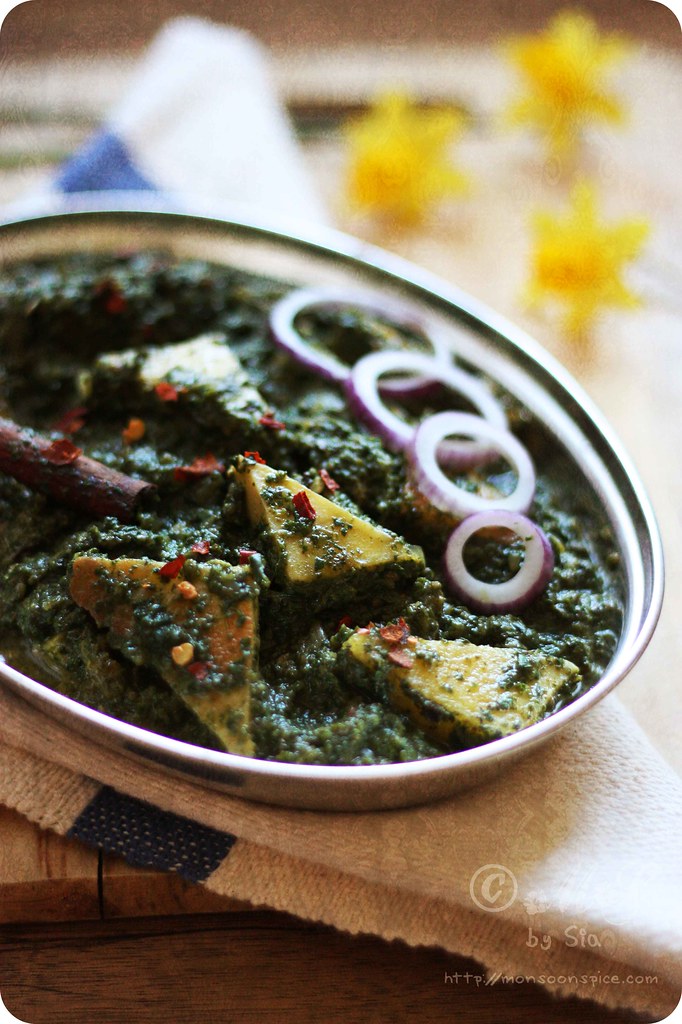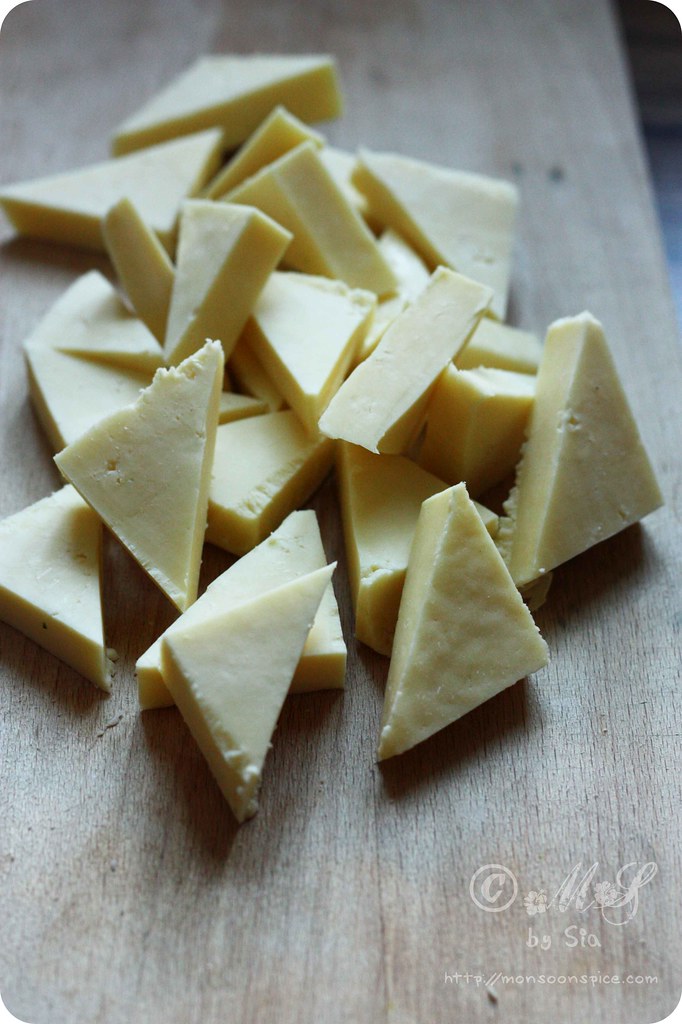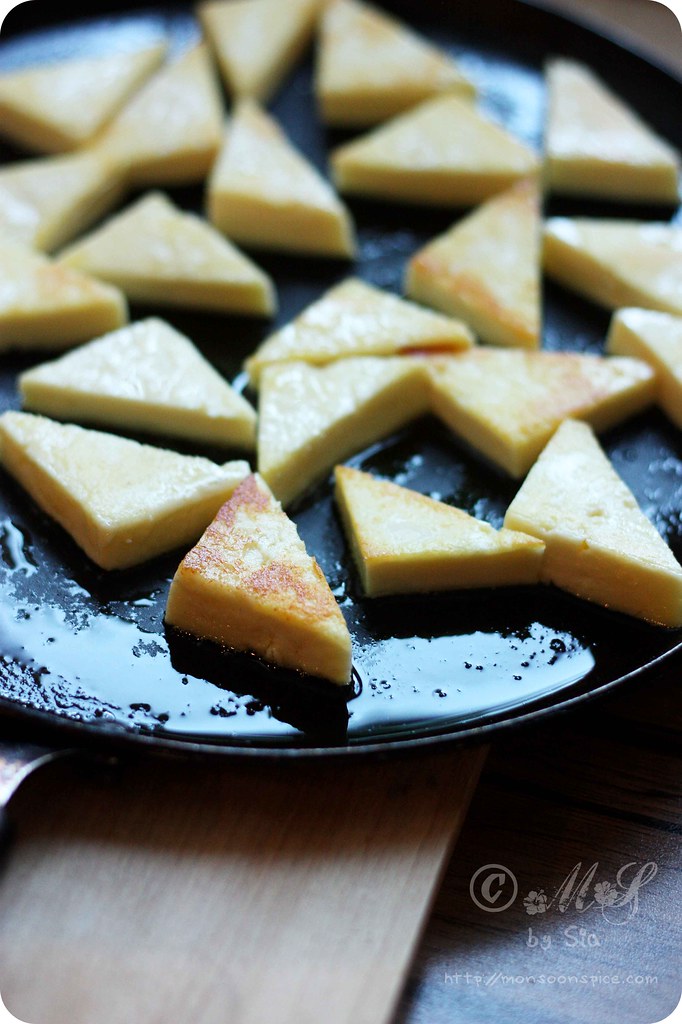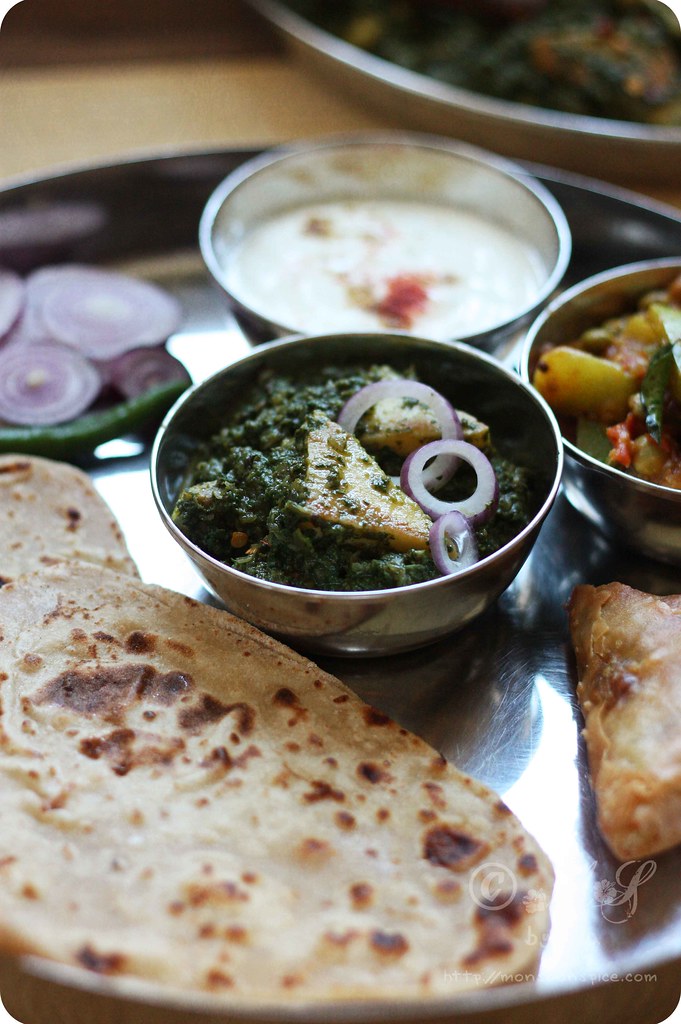


Saag in a Punjabi household (and my Mum is really renowned for her cooking among friends and family), usually refers to what you called Sarón da Saag. It is a mixture of Mustard greens, plus some Bathua leaves. My Mum buys her saag from a guy who comes the village in the afternoon from 4 onwards. He sells saag and bathua, both freshly picked that day. About 3 kgs of saag to 2 bunches of bathua leaves.
Saag is very tough, so yes, either slowly simmered or cooked in pressure cooker. One of my pet peeves in the internet is the way so many cooks give a paalak recipe for saag. There are 2 fundamental things with saag.
One, after it has been softened it is then mashed continuously while simmering with a "ghotna" and a certain amount of "makki da atta"- maize flour is added to it- slowly. That is what gives it a creamy texture and counterpoints the bitterness of the greens, but only slightly. This step is hard work and most people either skip it or just do it desultorily. But there is an expression in Punajbi that for hard work is called "saag ghotna" and it is not for nothing! You might do it with a potatoe masher if you do not have a ghotna handy.
The second thing is, you never ever add tomatoes to the saag tarka: it ruins the taste and makes it like any other green sabji.
After it has cooked at least half an hour with the makki the atta, and seasoned with salt. Now it is kept, in fact saag that is a couple of days old in the fridge is a lot tastier!
Then you take the quantity you want eat at that meal, and only put tarka on that one. Onions, green chillies, red chilli, ginger. Nothing else. And a dollop of white butter on the dish.
My mum serves it with ginger juliened and soaked in vinegar for a few hours. This saag of hers was in such demand that it was often sent to friends who lived long-distance (always without the tarka, which they would put themselves). And when it is made on a wood or coal fire it is even better (not usually possible!)
That is my experience of saag, hope you find it useful.



Palak Paneer (Indian cottage cheese in spicy spinach paste)
Prep Time: 10 mins
Cooking Time: 20-25 mins
Recipe Level: Easy/Beginner
Spice Level: Low to Medium
Serves: 6-7 people
Recipe Source: Mrs. Amritji
Shelf Life: 3 days when refrigerated and up to a month when frozen
Serving Suggestion: With any Indian flat breads (Whole Wheat Naan or Butter Naan or with any stuffed parathas) or plain/flavoured Basmati rice
Ingredients:
4-5 packed cups Spinach
1-1½ cups or 200 gms Paneer, cut into 1 inch long and 1 cm thick squares or triangles
2-3 Green Chillies, minced or finely chopped (Adjust acc to taste)
1 medium Onion, very finely chopped or grated
1 small Tomato, finely chopped
1 tsp Ginger-Garlic Paste
2 tbsp Fresh Cream or ¼ cup Whole Milk
1 tsp Sugar (Optional but recommended)
Juice of ½ fresh Lime (Adjust acc to taste)
1-2 tbsp Oil/Ghee
Salt to taste
Spices Used:
1 inch Cinnamon
4 Cloves
4 Green Cardamoms, lightly crushed
1 heaped tsp Dhania/Coriander Powder
½ tsp Jeera/Cumin Powder
½ tsp Garam Masala (Adjust acc to taste)
½ tsp Kitchen King Masala (Optional)
1 tbsp Kasuri Methi/Dried Fenugreek Leaves, crushed (Optional)
A pinch of Hing/Asafoetida (Optional)


Method:
- Bring the pot of water to boil and add about a tsp of sugar. Switch off the flame and add washed spinach leaves to them. Let it rest for one minute and drain all the water through colander. Bring the colander under running cold water to stop the spinach from cooking further. You can also steam cook the spinach for 2 minutes instead of blanching in hot water. Simply omit this step if you dont want to either steam or blanch the spinach.
- Next, based on your preference you can either finely chop or puree the spinach to smooth paste or simply grind it into rough paste by using food processor. I like to have little texture in Palak Paneer and hence I simply dumped the lot in food processor and pressed the pulse button few times to get rough spinach paste. Keep it aside until needed.
- Heat oil/ghee in a pan on medium flame and arrange paneer pieces in a single layer. Once they turns golden, about 1-2 mins, flip them over and cook the other side for another minute. Remove them from pan and either place them on a plate lined with kitchen towel or in a bowl of warm water which will help in keeping the paneer soft. This step is optional but recommended as it helps the paneer to hold its shape instead of crumbling when cooked in spinach gravy.
- In a same oil/ghee, add cinnamon, cloves and cardamoms. Fry them for half a minute.
- Next add hing and finely chopped onions and sauté on medium flame till they turn golden, about 3-5 minutes.
- Add ginger-garlic paste, minced green chillies, crushed kasuri methi and fry them for 3-4 mins until raw smell of ginger-garlic paste disappears.
- Add garam masala, kitchen king masala, coriander powder and cumin powder and stir them till the raw smell of the spices gives way to much harmonious and melodious aroma, about 1 minute. Add about table spoon of water if you think the spices are burning and sticking to the pan.
- Mix in chopped tomatoes and cook till they are pulpy and release their juice, about 2 minutes.
- Add the spinach, sugar and milk, little less than ¼ cups of water and mix them well. If using fresh cream instead of whole milk, add little less than ½ cup of water. Let them cook covered for about 5-6 minutes on medium flame. Add salt to taste and let it cook uncovered for another 3-5 minutes.
- Add paneer pieces and gently mix them so that the spices are evenly coated and let it simmer for 3 minutes before you switch off the flame.
- Drizzle freshly squeezed lime juice and serve this delicious Palak Paneer with any Indian flat breads (Whole Wheat Naan or Butter Naan or with any stuffed parathas) or plain/flavoured Basmati rice!

Sia’s Notes:
- If you prefer smooth spinach gravy, then simply grind the spinach to smooth puree by adding very little water at time.
- You can also blanch the spinach in boiling water with a tsp of sugar for about 3 minutes before pureeing. This will help in speeding the cooking process. Sugar helps in retaining the green colour of spinach.
- Take a look at Tofu Palak recipe where the spinach gravy is smooth and creamy. Paneer lovers can replace the tofu with paneer.
- Vegans can replace Paneer with Tofu and cow's milk with almond/soya milk.

thanks for sharing this.
ReplyDeleteThis is one of my favorite curry dishes and I have tried somewhat unsuccessfully to make this...once. Now I am encouraged to attempt this again. I have even shared this with my friends on facebook.
A mouthwatering dish! Just perfect in all ways.
ReplyDeleteCheers,
Rosa
Palak paneer is a all time favorite at our place. Love the way the paneer has been cut!
ReplyDeletesimply superb!!!loved your post, the authentic recipe and awesome clicks !!great..
ReplyDeleteAnjana
palak paneer and rice... my fav any day. nice clicks too sia.
ReplyDeletecoming from a punjabi household, i totally agree with your post and mrs a.
i and my mom in law have spend hours cooking sarson ka saag. so much chopping, cleaning, cooking then blending, then again cooking.... but worth the time spent. and we used to make in bulk for many people... so you can imagine.
i do have a recipe for palak saag on my site. when i made this, i finished cooking in some 40-45 minutes.... so easy and quick. do check it out when you have time.
My tummy is rumbling (along with the thunder outside) at the sight of this delicious bowlful. The is one of our favorites at home and T will complain if a week goes by and she does not have it. The clarification of the Saag and Palak will help a many ;D
ReplyDeleteThank you for that explanation of the difference between saag and palak--I've always wondered. Someone once told me in India that saag was a wild green that grew in the north, but I was never really clear since recipes tend to just use spinach.
ReplyDeleteThis post reminded me of my trip to Amritsar, where i tasted Sarson ka saag at a Dhaaba near Jallianwala Bagh for the first time, just out of the world :)
ReplyDeleteBeautiful post and pictures as always sia.
i had no idea saag refered to a combination of greens, so a saag paneer would taste entirely different from palak paneer! hmm, i never knew this. i love the slightly coarish texture u have achieved.. looks divine
ReplyDeleteLoved the recipe and mouth watering pics.
ReplyDeleteI've never added tomato to palak-paneer.
Would try it this time.
Cheers,
Sapna
hi sia,
ReplyDeletethis is the best palak paneer that i have ever tried. Made it today and had it with rotis. tasted gr8! Thank u. your site has become my cooking bible now :)
@Unknown, That's wonderful:) I am glad u enjoyed it!
ReplyDeleteSiam,made this with tofu instead of paneer. Was yum.thanks for sharing
ReplyDeleteSonia
this is one of those situations where google is letting me down- everyone has a different opinion on how much spinach you can pack into a cup! How much do your 4-5 cups of spinach weigh (in g or oz)?
ReplyDelete@Helen, sorry I won't be able to tell u exact weight as how much 4-5 cups of spinach weights (I neighter I have patience to weight every thing i cook as I have 22 month old toddler running around in the kictehn and clinging to my dress all the time i cook and nor I own any weighing machine to measure the ingredients). Indian cooking is very flexible (and many of us use our insticnt than weighing machines) and any standard mesuring cups can be used in measuing the quntities mentioned here. and there any many websites which will help u in convertions from cups to gms, lbs etc. hope this helps!
ReplyDelete@helen: i used 2 bunches of spinach for this recipe
ReplyDelete@Unknown, thanks! since i used baby spinach I could only give measurement in cups. your comment will be helpful for many ppl :)
ReplyDelete@Sonia, I don't know how I missed out reading your comment! thanks a lot for letting me know. tofu is deinately a healthier choice and I myself use it quite often in place of paneer. I am glad u enjoyed it :)
ReplyDeleteSia,
ReplyDeleteThank you for your blog... the recipes I have found are delightful and inspiring. Having been brought up on typically English-Indian food its so refreshing to see so many lovely vegetable recipes that are now gracing our dinner plates at home.
I'd just like to say that the spice mixturesyou use here in the Palak Paneer is gorgeous, and although I dropped the chili (for my wife's palate) and swapped the paneer, the result was one of the best spinach based curries I've cooked.
Thank you for giving us all the recipe!
Andy
@Andy Workman, a positive feedback by the readers of my blog who tried the recipe and loved it always inspires and motivates me! Thank you so much for taking time and writing to me :) I greatly appreciate it.
ReplyDeleteThis comment has been removed by a blog administrator.
ReplyDeleteHi Sia,
ReplyDeleteYour measurements are spot on and it tastes so great! Thank you for sharing your recipes. :)
It was just delicious, tasty.. absolutely fabulous! Thank you very much for this recipe:-)
ReplyDeletei am so incredibly excited to eat this, just waiting on my basmati rice. thank you, this, just based on the spices and technique, will, hands down, beat the recipe i found on another site (and made) earlier this week. looking forward to making more of your recipes in the near future. cheers!
ReplyDelete@cher, thank you for leaving such positive feedback! Do keep me posted about the recipes you plan to try and let me know if you have any queries :)
ReplyDeleteNice..Saag is made by adding little basen or makka aata to the spinach batter in the form of "aalan" as an binding agent, while in palak paneer aalan is not added in the greater panjab food (Punjabi food). This is the main difference between the two,
ReplyDeleteHi Sia. I joined your FB page sometime back and when you posted this palak paneer recipe i decided then n there to cook it... And voila today i did so... it has turned out to be lip-smacking delicious and the best palak paneer i have ever cooked or eaten... the sutle taste of the spices go so well with the palak n paneer... Thanks for sharing this wonderful recipe.
ReplyDeleteCheers
Kavita
@healthycookingwithkusum, that's really interesting tip. thank you :)
ReplyDelete@kavita, thanks for such positive feedback Kavita :) I am really happy to know u enjoyed it!
ReplyDeleteHi Sia, I just tried this few days ago and finally got around posting it on my blog today. This is a fantastic recipe with wonderful aroma and flavour. I loved it. Thank you so much for sharing this.
ReplyDelete@Uj, that's fantastic. will check your blog :)
ReplyDeleteMay I add my two cents/paisa? Saag in a Punjabi household (and my Mum is really renowned for her cooking among friends and family), usually refers to what you called Sarón da Saag. It is a mixture of Mustard greens, plus some Bathua leaves. My Mum buys her saag from a guy who comes the village in the afternoon from 4 onwards. He sells saag and bathua, both freshly picked that day. About 3 kgs of saag to 2 bunches of bathua leaves.
ReplyDeleteSaag is very tough, so yes, either slowly simmered or cooked in pressure cooker. One of my pet peeves in the internet is the way so many cooks give a paalak recipe for saag. There are 2 fundamental things with saag.
One, after it has been softened it is then mashed continuously while simmering with a "ghotna" and a certain amount of "makki da atta"- maize flour is added to it- slowly. That is what gives it a creamy texture and counterpoints the bitterness of the greens, but only slightly. This step is hard work and most people either skip it or just do it desultorily. But there is an expression in Punajbi that for hard work is called "saag ghotna" and it is not for nothing! You might do it with a potatoe masher if you do not have a ghotna handy.
The secondthing is, you never ever add tomatoes to the saag tarka: it ruins the taste and makes it like any other green sabji.
After it has cooked at least half an hour with the makki the atta, and seasoned with salt. Now it is kept, in fact saag that is a couple of days old in the fridge is a lot tastier!
Then you take the quantity you want eat at that meal, and only put tarka on that one. Onions, green chillies, red chilli, ginger. Nothing else. And a dollop of white butter on the dish.
My mum serves it with ginger juliened and soaked in vinegar for a few hours. This saag of hers was in such demand that it was often sent to friends who lived long-distance (always without the tarka, which they would put themselves). And when it is made on a wood or coal fire it is even better (not usually possible!)
That is my experience of saag, hope you find it useful.
@bawa, I can't thank you enough for taking time and explaining how exactly Saag is made! I have learnt so much from your comment and I am sure many readers will find it quite useful in their quest for learning about authentic Saag. I will update my post with the information you shared. thank you once again :)
ReplyDeleteI have made this few times...but always found it lacking in flavour andspice...i will trythis one
ReplyDeleteI have made this few times...but always found it lacking in flavour andspice...i will trythis one
ReplyDelete@Sylvie, hope u enjoy this one :)
ReplyDeleteSia, when paneer is fried..it releases water ..is that ok? doesn't fry so good after that.
ReplyDelete@Maina Shet, you are right. It does release water and splatteres when fried. I fry it if the paneer is store brought. You don't need to fry them for longer.Just enough to get nice golden crust on top. However you can skip frying if using homemade paneer.
ReplyDeletePerfect Recipe!!! Tried it! Loved it! Wowed Everyone!!!
ReplyDeleteThanks for sharing this recipe.
ReplyDelete